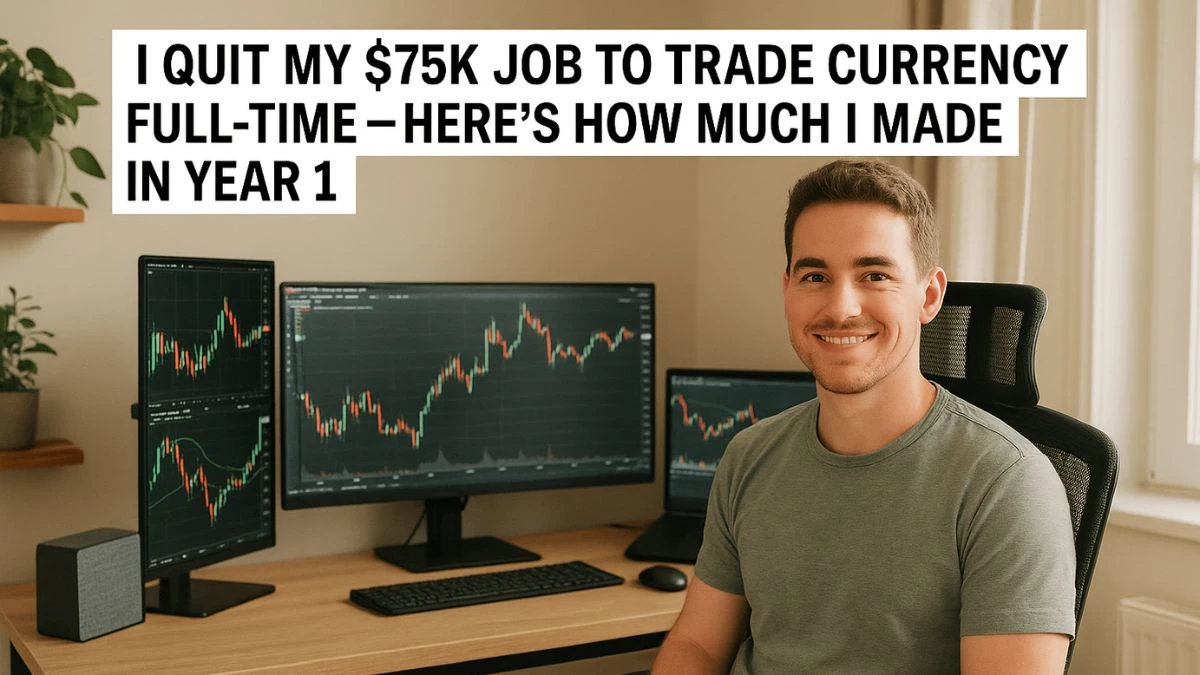
I Quit My $75K Job to Trade Currency Full-Time - Here's How Much I Made in Year 1
A 32-year-old quit his $75,000 corporate job to trade currency full-time. Here's his honest first-year income breakdown, wins, losses, and lessons learned.
by Admin
Published Nov 01, 2025 | Updated Nov 01, 2025 | 📖 8 min read
On November 1, 2024, I walked into my manager's office and resigned from my $75,000-per-year corporate marketing job to become a full-time currency trader. My family thought I was crazy. My friends questioned my sanity. My financial advisor strongly advised against it.
One year later, on November 1, 2025, I'm sharing the complete truth about what happened—the actual numbers, the mistakes I made, the lessons I learned, and whether quitting my stable job to trade forex was the best or worst decision of my life.
Why I Made the Leap
I'm Michael Chen, 32 years old, living in Austin, Texas. I had been trading currencies part-time for three years while working my corporate job, starting with $5,000 in 2021.
By October 2024, I had grown that $5,000 to $47,000 through disciplined trading—a 940% return over three years. More importantly, I had developed a consistent system that was generating $3,000-$5,000 monthly in part-time trading income.
The math seemed clear: if I could make $3,000-$5,000 monthly while working full-time elsewhere, dedicating 40+ hours weekly to trading could potentially double or triple that income.
Plus, I was miserable in corporate life. The endless meetings, office politics, and feeling like a cog in a machine wore me down. Trading offered freedom, intellectual challenge, and the possibility of uncapped earnings.
So I did something most people think about but never actually do—I quit.
The Setup: My Trading Capital and Strategy
When I started full-time trading on November 1, 2024, my situation was:
- Trading capital: $50,000 (my $47,000 account plus $3,000 added)
- Emergency fund: $30,000 (6 months of living expenses at $5,000/month)
- Living expenses: $5,000 monthly ($60,000 annually)
- Healthcare: $450 monthly for marketplace insurance (no longer had employer coverage)
- Strategy: Primarily trading USD/INR, EUR/USD, GBP/USD, and USD/JPY pairs
My trading approach focuses on technical analysis combined with macroeconomic events. I don't gamble on random movements—I wait for high-probability setups based on support/resistance levels, moving averages, and central bank policy shifts.
My rules:
- Never risk more than 1% of capital on a single trade
- Maintain 2:1 minimum risk-reward ratio
- Trade only during high-liquidity hours (London/New York overlap)
- No revenge trading after losses
- Maximum 5 trades per day
The Results: What I Actually Made
Here's the complete breakdown of my first year trading full-time:
Month 1-3 (November 2024 - January 2025): The Honeymoon
Trading gains: +$14,200
Average monthly: $4,733
The first quarter exceeded expectations. I caught a major USD weakness trend that I rode for substantial profits. The combination of more screen time, better entry timing, and several Fed policy-driven moves created ideal conditions.
I felt validated. The doubters were wrong. I was crushing it.
Month 4-6 (February - April 2025): Reality Check
Trading gains: -$6,800 (yes, negative)
Average monthly: -$2,267
Then reality hit. Markets became choppy, trending strategies stopped working, and I made two critical mistakes:
- I increased position sizes too aggressively after early success (violating my 1% risk rule)
- I tried to force trades during low-volatility periods instead of staying patient
A single terrible week in March wiped out $4,200 in profits. I learned that bad weeks happen even to disciplined traders.
Month 7-9 (May - July 2025): The Adjustment
Trading gains: +$11,400
Average monthly: $3,800
I returned to basics—strict risk management, patient trade selection, and accepting that some months would be flat or slightly negative. The dollar's 10.24% year-to-date decline created excellent long-term shorting opportunities.
Month 10-12 (August - October 2025): Finding Rhythm
Trading gains: +$15,900
Average monthly: $5,300
The final quarter was my strongest. Major macro events (Fed rate cuts, gold volatility, recession warnings) created the high-probability setups I specialize in. My experience recognizing these patterns improved dramatically.
Final Year 1 Numbers
Total trading gains: $34,700
Starting capital: $50,000
Ending capital: $84,700
Return on capital: 69.4%
But here's what I actually "made" in income terms:
- Trading gains: $34,700
- Capital withdrawn for living expenses: -$48,000 (from emergency fund, not trading account)
- Healthcare costs: -$5,400
- Trading expenses (data, software, education): -$3,200
- Self-employment tax (estimated): -$5,300
Net financial position vs. keeping my job:
- If I had kept my job: $75,000 salary - $7,500 taxes - $0 healthcare (employer-covered) = $67,500 net
- From trading: $34,700 - $3,200 expenses - $5,300 taxes = $26,200 net + $36,700 capital increase = $62,900 total
Income difference: I made $4,600 less than my old job while working much harder and taking on significant stress.
The Honest Truth: Was It Worth It?
Financially, year one was essentially a break-even proposition. I made slightly less money, worked longer hours, and depleted my emergency fund.
But here's what the numbers don't show:
What I Gained:
- Freedom: Work from anywhere, set my own schedule, no commute
- Skill development: I'm exponentially better at trading than 12 months ago
- Scalability: My $84,700 capital base can generate more income in year 2
- No income ceiling: Unlike my $75K capped salary, trading income has no limit
- Intellectual fulfillment: I'm engaged and challenged daily, not bored in meetings
- Mental toughness: Handling losses and volatility has made me psychologically stronger
What I Lost:
- Income stability: Some months I made $8,000, others I lost $3,000
- Benefits: No employer healthcare, 401k match, or paid vacation
- Social connection: Trading is solitary; I miss office friendships
- Career safety net: If trading fails, returning to corporate work may be harder
- Peace of mind: Markets can tank your account 24/7, weekends included
The Biggest Lessons Learned
1. Part-Time Success ≠ Full-Time Success
Making $4,000 monthly part-time doesn't guarantee $8,000 monthly full-time. More screen time can lead to overtrading. My February-April losses came from forcing trades because "I should be working."
2. Risk Management is Everything
The 1% risk rule saved me from blowing up my account. That terrible March week would have destroyed me if I'd been risking 3-5% per trade like some aggressive traders do.
3. You Can't Control Markets, Only Your Response
Some months, markets simply don't present good opportunities. Accepting $0 income months is smarter than forcing bad trades that create -$3,000 months.
4. Psychology is Harder Than Strategy
I have a profitable strategy. The challenge is executing it consistently without letting fear (after losses) or greed (after wins) override discipline.
5. Capital Requirements Are Higher Than You Think
$50,000 felt adequate but was actually tight. I needed to generate 96% returns just to match my old salary before taxes. Starting with $100,000+ would provide more realistic income potential with conservative risk management.
Would I Do It Again?
Yes, but with modifications:
- Larger starting capital: I'd want $75,000-$100,000 in trading capital plus 12 months emergency fund
- Hybrid income: I'd maintain a part-time consulting gig for income stability
- Realistic expectations: Plan for year 1 to match (not exceed) previous income while building skills
- Better work-life boundaries: I checked markets obsessively, even at 3am; healthier limits needed
Advice for Anyone Considering This Path
You Should NOT Quit Your Job to Trade If:
- You have less than 2 years profitable trading experience
- Your trading capital is under $50,000
- You don't have 6-12 months emergency fund
- You can't handle income volatility emotionally
- You have dependents relying on stable income
- You're using this to escape problems rather than pursue passion
You MIGHT Consider It If:
- You have 3+ years of profitable trading history
- Your part-time trading consistently generates 40%+ annual returns
- You have $75,000+ trading capital plus emergency fund
- You can handle psychological stress of daily PnL swings
- You have health insurance alternatives (spouse, marketplace, etc.)
- You're genuinely passionate about markets, not just money
Year 2 Goals and Strategy
I'm continuing full-time trading in year 2 with these modifications:
- Income target: $90,000 (20% above old salary to account for benefits lost)
- Required return: 106% on $84,700 capital to hit that target
- Risk adjustment: Willing to risk 1.5% per trade (vs 1%) given larger capital base
- Diversification: Adding gold and crypto trading to currency pairs
- Part-time income: Taking 2-3 consulting projects annually for stability
The advantage of year 2 is my capital base increased 69.4% to $84,700. The same 69% return now generates $58,400 instead of $34,700—bringing me closer to old salary with identical performance.
The Bottom Line
Quitting my $75K job to trade currency full-time was simultaneously the best and worst decision I've made. Financially, year one was marginally worse than staying employed. Psychologically and developmentally, it was transformative.
I'm not rich. I'm not driving a Lamborghini. I'm not posting Instagram photos of champagne and watches like scam "forex gurus." I'm a regular person who took a calculated risk, worked extremely hard, made less money than expected, and is betting on long-term potential over short-term comfort.
For most people reading this, keeping your day job while trading part-time is the smarter choice. The income stability, benefits, and reduced stress outweigh the romantic notion of "trading for a living."
But for those few who have the capital, experience, risk tolerance, and genuine passion for markets—it's possible to make this work. Just know it's harder than it looks, takes longer than you hope, and costs more than you expect.
Year one taught me I can survive as a trader. Year two will determine if I can thrive.
FAQs - Full-Time Currency Trading Income and Experience
. How much money did you actually make trading currency in year 1?
I made $34,700 in trading gains on $50,000 starting capital (69.4% return). However, after withdrawing $48,000 for living expenses from emergency fund, paying $5,400 healthcare, $3,200 trading expenses, and $5,300 taxes, my net position was $62,900 total—about $4,600 less than my previous $75,000 job would have provided.
. What currency pairs do you trade most often?
I primarily trade USD/INR, EUR/USD, GBP/USD, and USD/JPY pairs. These major and emerging market pairs offer high liquidity, tight spreads, and respond predictably to macroeconomic events like Federal Reserve policy, inflation data, and geopolitical developments. The USD's 10.24% year-to-date decline created excellent shorting opportunities throughout 2025.
. How much capital do you need to trade forex full-time?
I recommend $75,000-$100,000 in trading capital plus 6-12 months emergency fund. I started with $50,000 which felt tight—I needed 96% returns just to match my old salary. With $100,000 capital, a more realistic 60% return generates $60,000 income with lower risk. Never trade with money you can't afford to lose.
. What was your worst trading month and how did you recover?
March 2025 was my worst—I lost $4,200 in a single week by violating my risk management rules (increasing position sizes too aggressively and forcing trades during low volatility). I recovered by returning to strict 1% risk per trade, taking only high-probability setups, and accepting that some months will have zero good trading opportunities.
. Do you regret quitting your $75K corporate job?
No, despite making $4,600 less in year 1. I gained freedom, intellectual fulfillment, skill development, and no income ceiling. However, I lost stability, benefits, and peace of mind. For most people, keeping a day job while trading part-time is smarter. But I'm betting on long-term potential—my larger capital base ($84,700) makes year 2 more promising.
. What trading strategy or system do you use?
I use technical analysis (support/resistance, moving averages) combined with macroeconomic catalysts (Fed rate cuts, inflation data, geopolitical events). My rules: never risk more than 1% capital per trade, maintain 2:1 minimum risk-reward ratio, trade only during high-liquidity hours, no revenge trading after losses, maximum 5 trades daily.
. How much time per day do you spend trading?
Actual trading execution is 2-3 hours during London/New York market overlap (8am-11am EST). Analysis, research, and market monitoring adds another 3-4 hours. Total working time is 6-8 hours daily, but I check markets obsessively (even 3am)—a habit I'm working to improve for better work-life balance.
. What advice would you give someone wanting to quit their job to trade?
Don't do it unless you have: 3+ years profitable trading experience, $75,000+ trading capital, 6-12 months emergency fund, consistent 40%+ annual returns part-time, health insurance alternatives, and can handle psychological stress of daily profit/loss swings. Most people should keep their day job and trade part-time for stability and benefits.
. How do taxes work for full-time currency traders?
Forex trading income is taxed as ordinary income, not capital gains. You also pay self-employment tax (approximately 15.3% on net earnings). I paid estimated $5,300 in taxes on $34,700 gains. You can deduct trading expenses (data feeds, software, education) and home office costs. Consult a CPA familiar with trader tax status—it's complicated.
. What is your year 2 income goal and strategy?
Year 2 goal is $90,000 income (20% above old salary to account for lost benefits). This requires 106% return on my $84,700 capital base. I'm adjusting risk to 1.5% per trade (vs 1%), diversifying into gold and crypto alongside currency pairs, and taking 2-3 consulting projects annually for income stability while building my trading career.




